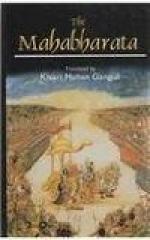71. i.e., truth is the Sastra of the Prasastri.
72. Narayana is taken by Nilakantha to stand here for either the Veda or the Soul. The animals offered up to Narayana in days of old were the senses offered up as sacrifices.
73. Srota here means preceptor or dispeller of doubts. Amaratwam is the status of the immortal head of all.
74. I think Telang is not correct in his rendering of this verse. What is stated here is plain, viz., that it is He who is the preceptor and the disciple. Ayam srinoti,—’prochyamanam grihnati,—’tat prichcchatah ato bhuyas anye srinanti is the grammar of the construction. The conclusion then comes—’gururanyo na vidyate’.
75. One who understands the truth.
76. The seven large trees are the five senses, the mind, and the understanding. The fruits are the pleasures and pains derived from or through them. The guests are the powers of each sense, for it is they that receive those pleasures and pains. The hermitages are those very trees under which the guests take shelter. The seven forms of Yoga are the extinctions of the seven senses. The seven forms of initiation are the repudiation, one after another, of the actions of the seven senses.
77. The correct reading is bhavantyanityah and vahuswabhavan.
78. Swabhava is explained by Nilakantha as sutaram abhava.
79. The sense seems to be this; the life-winds indicate the operations of the several organs of action: the tongue, which stands here for all the organs of perception, of the sensual perceptions; the mind, of all the internal operations; the quality of goodness, of all pleasure; and the quality of passion, of all kinds of pain. These, therefore include the whole external and the internal worlds. He that is free from these, transcends sin, for sin is destroyed by freedom from these, knowledge being the means of attaining to that freedom.
80. ’I have no fault etc.’—The sense seems to be that by doing these rites with the aid of Mantras I have done that which has been approved from ages past by those who have always been regarded wise. My eyes, however, have now been opened by thee. I should not be held responsible for what I did while I was ignorant.
81. Kshatriyas always require Brahmanas for assisting them in their acts. These particular Kshatriyas, through fear of Rama, fled to the forests and mountains. They could not, accordingly, find Brahmanas for assisting them. Their children, therefore, fell away from the status of Kshatriyas and became Vrishalas or Sudras.
82. Kshatriya-bandhu always implies low or inferior Kshatriyas, as Brahma-bandhu implies low or inferior Brahmanas. The expression, very probably, is similar to Brahman-sangat in current Bengali. It does not surely mean ‘kinsmen of Kshatriyas’.
83. The vocative, ‘O foremost of regenerate ones’ applies to Jamadagni’s son. The narration is that of the Pitris. All the copies, however, represent this as the Brahmana’s speech to his wife. Indeed, the Brahmana is only reciting to his wife the speech of the Pitris to Rama. The Yoga here spoken of is, as Nilakantha explains the Raja-Yoga. Previously, Alarka had been bent upon Hatha-Yoga which frequently ends in the destruction of the person practising it.




